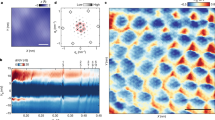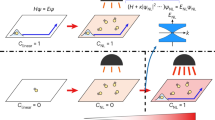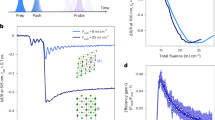Abstract
The lowest-lying fundamental excitation of an incommensurate charge-density-wave material is believed to be a massless phason—a collective modulation of the phase of the charge-density-wave order parameter. However, long-range Coulomb interactions should push the phason energy up to the plasma energy of the charge-density-wave condensate, resulting in a massive phason and fully gapped spectrum1. Using time-domain terahertz emission spectroscopy, we investigate this issue in (TaSe4)2I, a quasi-one-dimensional charge-density-wave insulator. On transient photoexcitation at low temperatures, we find the material strikingly emits coherent, narrowband terahertz radiation. The frequency, polarization and temperature dependences of the emitted radiation imply the existence of a phason that acquires mass by coupling to long-range Coulomb interactions. Our observations underscore the role of long-range interactions in determining the nature of collective excitations in materials with modulated charge or spin order.
This is a preview of subscription content, access via your institution
Access options
Access Nature and 54 other Nature Portfolio journals
Get Nature+, our best-value online-access subscription
$29.99 / 30 days
cancel any time
Subscribe to this journal
Receive 12 print issues and online access
$259.00 per year
only $21.58 per issue
Buy this article
- Purchase on Springer Link
- Instant access to full article PDF
Prices may be subject to local taxes which are calculated during checkout




Similar content being viewed by others
Data availability
Source data are provided with this paper. Additional data are available from the corresponding author upon reasonable request.
References
Lee, P. A. & Fukuyama, H. Dynamics of the charge-density wave. II. Long-range Coulomb effects in an array of chains. Phys. Rev. B 17, 542–548 (1978).
Schwartz, M. D. Quantum Field Theory and the Standard Model (Cambridge Univ. Press, 2013).
Fradkin, E. Field Theories of Condensed Matter Physics (Cambridge Univ. Press, 2013).
Anderson, P. W. Plasmons, gauge invariance, and mass. Phys. Rev. 130, 439–442 (1963).
Grüner, G. The dynamics of charge-density waves. Rev. Mod. Phys. 60, 1129–1181 (1988).
Lee, P. A., Rice, T. M. & Anderson, P. W. Fluctuation effects at a Peierls transition. Phys. Rev. Lett. 31, 462–465 (1973).
Wong, K. Y. M. & Takada, S. Effects of quasiparticle screening on collective modes: incommensurate charge-density-wave systems. Phys. Rev. B 36, 5476–5492 (1987).
Virosztek, A. & Maki, K. Collective modes in charge-density waves and long-range Coulomb interactions. Phys. Rev. B 48, 1368–1372 (1993).
Wang, Z. et al. Charge density wave transport in (TaSe4)2I. Solid State Commun. 46, 325–328 (1983).
Maki, M., Kaiser, M., Zettl, A. & Grüner, G. Charge density wave transport in a novel inorganic chain compound (TaSe4)2I. Solid State Commun. 46, 497–500 (1983).
Fujishita, H., Sato, M. & Hoshino, S. Incommensurate superlattice reflections in quasi one dimensional conductors (MSe4)2I (M=Ta and Nb). Solid State Commun. 49, 313–316 (1984).
Donovan, S., Kim, Y., Alavi, B., Degiori, L. & Gruner, G. The optical spectrum of charge density wave condensates. Solid State Commun. 75, 721–724 (1990).
Degiorgi, L. & Grüner, G. Pinned and bound collective-mode state in charge-density-wave condensates. Phys. Rev. B 44, 7820–7827 (1991).
Gooth, J. et al. Axionic charge-density wave in the Weyl semimetal (TaSe4)2I. Nature 575, 315–319 (2019).
Sakai, K. (ed) Terahertz Optoelectronics (Springer, 2005).
Rees, D. et al. Helicity-dependent photocurrents in the chiral Weyl semimetal RhSi. Sci. Adv. 6, 29 (2020).
Gao, Y. et al. Chiral terahertz wave emission from the Weyl semimetal TaAs. Nat. Commun. 11, 720 (2020).
Luo, L. et al. A light-induced phononic symmetry switch and giant dissipationless topological photocurrent in ZrTe5. Nat. Mater. 20, 329–334 (2021).
Dekorsy, T., Auer, H., Bakker, H. J., Roskos, H. G. & Kurz, H. THz electromagnetic emission by coherent infrared-active phonons. Phys. Rev. B 53, 4005–4014 (1996).
Schaefer, H. et al. Dynamics of charge density wave order in the quasi one dimensional conductor (TaSe4)2I probed by femtosecond optical spectroscopy. Eur. Phys. J. Spec. Top. 222, 1005–1016 (2013).
Lorenzo, J. E., Currat, R., Monceau, P., Hennion, B. & Levy, F. Neutron investigation of optic-phonon branches in the quasi-one-dimensional compound (TaSe4)2I. Phys. Rev. B 47, 10116–10121 (1993).
Nguyen, Q. L. et al. Ultrafast X-ray scattering from collective modes of the charge density wave in (TaSe4)2I. Preprint at arXiv https://arxiv.org/abs/2210.17483 (2022).
Shi, W. et al. A charge-density-wave topological semimetal. Nat. Phys. 17, 381–387 (2021).
Sugai, S., Sato, M. & Kurihara, S. Interphonon interactions at the charge-density-wave phase transitions in (TaSe4)2I and (NbSe4)2I. Phys. Rev. B 32, 6809–6818 (1985).
Lorenzo, J. E. et al. A neutron scattering study of the quasi-one-dimensional conductor. J. Phys.: Condens. Matter 10, 5039–5068 (1998).
Fujishita, H., Shapiro, S. M., Sato, M. & Hoshino, S. A neutron scattering study of the quasi-one-dimensional conductor (TaSe4)2I. J. Phys. C: Solid State Phys. 19, 3049–3057 (1986).
Kim, T. W., Donovan, S., Grüner, G. & Philipp, A. Charge-density-wave dynamics in (Ta1–xNbxSe4)2I alloys. Phys. Rev. B 43, 6315–6325 (1991).
Zeiger, H. J. et al. Theory for displacive excitation of coherent phonons. Phys. Rev. B 45, 768–778 (1992).
Yamamoto, A., Mishina, T., Masumoto, Y. & Nakayama, M. Coherent oscillation of zone-folded phonon modes in GaAs-AlAs superlattices. Phys. Rev. Lett. 73, 740–743 (1994).
Park, H., Wang, X., Nie, S., Clinite, R. & Cao, J. Mechanism of coherent acoustic phonon generation under nonequilibrium conditions. Phys. Rev. B 72, 100301 (2005).
Sinchenko, A. A., Ballou, R., Lorenzo, J. E., Grenet, T. & Monceau, P. Does (TaSe4)2I really harbor an axionic charge density wave? Appl. Phys. Lett. 120, 063102 (2022).
Acknowledgements
We thank P. Abbamonte, P. Armitage, D. Chaudhuri, T.-C. Chiang, L. Cooper, S. Kivelson, A. Kogar, P. Lee, V. Madhavan, D. Torchinsky and B. Wieder for insightful discussions. This work was supported by the Quantum Sensing and Quantum Materials, an Energy Frontier Research Center, funded by the US Department of Energy (DOE), Office of Science, Basic Energy Sciences (BES), under award no. DE-SC0021238. F.M. acknowledges support from the EPiQS program of the Gordon and Betty Moore Foundation (grant GBMF11069). R.A.D. acknowledges support from the Bloch Postdoctoral Fellowship in Quantum Science and Engineering of the Stanford University Quantum Fundamentals, Architectures, and Machines initiative (Q-FARM), and from the Karel Urbanek and Marvin Chodorow Postdoctoral Fellowship of the Department of Applied Physics at Stanford University. X.-Q.S. acknowledges support from the Gordon and Betty Moore Foundation’s EPiQS Initiative through grant GBMF8691. We acknowledge the use of the spectroscopic ellipsometry setup at the Institute for Basic Science (IBS) in Korea (grant no. IBS-R009-D1).
Author information
Authors and Affiliations
Contributions
S.K., Y.L., N.B., A.M. and F.M. performed the THz emission spectroscopy experiments and the corresponding data analysis. X.-Q.S. and B.B. developed the theoretical understanding and modelling. C.Z., K.Q. and D.P.S synthesized and characterized the samples. R.A.D., Q.L.D.N. and M.T. gave crucial insights into the understanding and analysis of the data. S.K., X.-Q.S., B.B. and F.M. wrote the manuscript with input from all the authors. F.M. conceived and supervised this project.
Corresponding author
Ethics declarations
Competing interests
The authors declare no competing interests.
Peer review
Peer review information
Nature Materials thanks Manfred Fiebig and the other, anonymous, reviewer(s) for their contribution to the peer review of this work.
Additional information
Publisher’s note Springer Nature remains neutral with regard to jurisdictional claims in published maps and institutional affiliations.
Supplementary information
Supplementary Information
Supplementary Figs. 1–9 and discussion.
Source data
Source Data Fig. 2
Source data.
Source Data Fig. 3
Source data.
Rights and permissions
Springer Nature or its licensor (e.g. a society or other partner) holds exclusive rights to this article under a publishing agreement with the author(s) or other rightsholder(s); author self-archiving of the accepted manuscript version of this article is solely governed by the terms of such publishing agreement and applicable law.
About this article
Cite this article
Kim, S., Lv, Y., Sun, XQ. et al. Observation of a massive phason in a charge-density-wave insulator. Nat. Mater. 22, 429–433 (2023). https://doi.org/10.1038/s41563-023-01504-5
Received:
Accepted:
Published:
Issue Date:
DOI: https://doi.org/10.1038/s41563-023-01504-5
This article is cited by
-
Chirality manipulation of ultrafast phase switches in a correlated CDW-Weyl semimetal
Nature Communications (2024)
-
Chiral symmetry restoration and the ultraquantum limit of axionic Charge Density Waves in Weyl Semimetals
Journal of High Energy Physics (2024)



